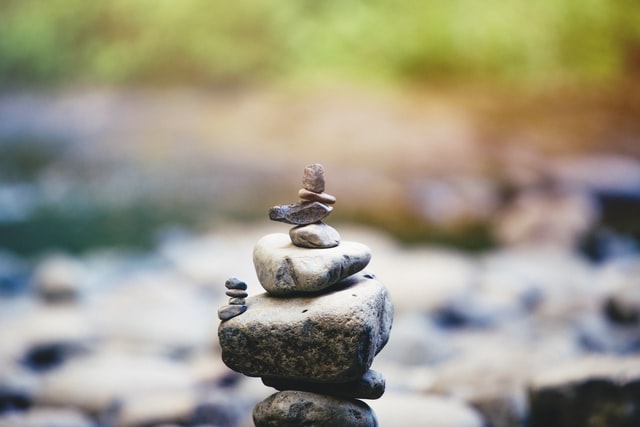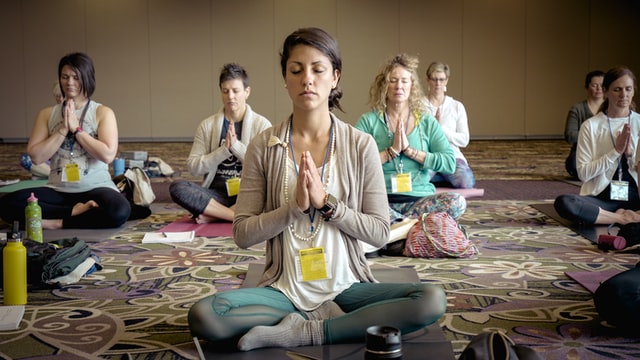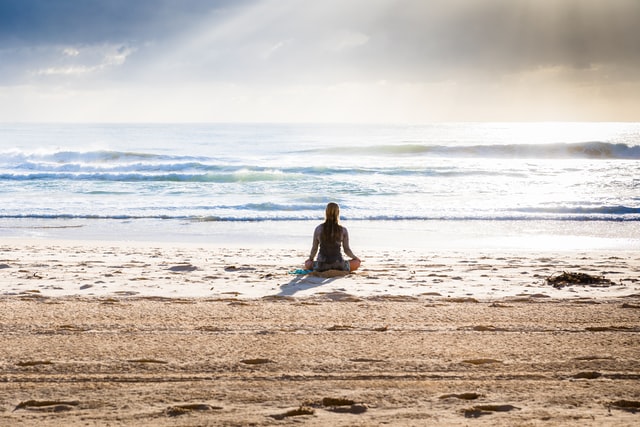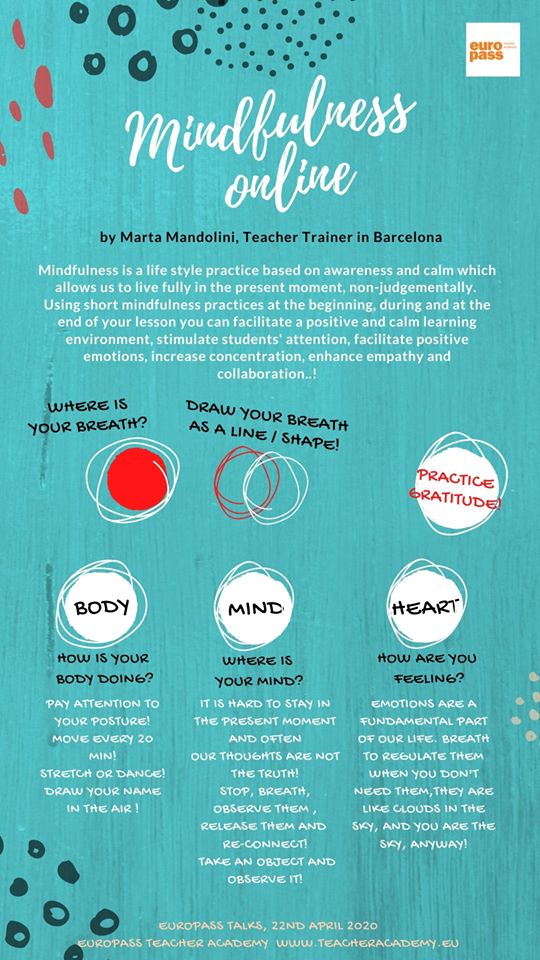If you are “Mind Full” you are probably experiencing some physical tension (pain, tight muscles) or emotional tension (stress, anxiety) in your body. This could also lead to difficulty in concentrating or making decisions.
You might also be engaging in some bad habits and perhaps you are not enjoying what you are doing. If you are experiencing a “Mindful” you, you are probably observing the opposite: you do not have any particular physical or emotional tension, you are focused, engaged with the present, and fully aware of what your experience in the here and now is and what it feels like.
What is Mindfulness? | Mindfulness origins
Mindfulness can be defined as: “awareness that arises through paying attention, on purpose, in the present moment, non-judgmentally, as if your life depended on it” (Jon Kabat Zinn).
Mindfulness is not a relaxing technique, even though a relaxed state can be one of the results; it is a lifestyle practice.
Mindfulness can be cultivated in different ways, as we will see in this article.
Meditation is one way, but not necessarily the main one. Some people are actually quite skeptical of meditation and may have resistance to practicing it.
Someone may also confuse Mindfulness with religion, but it has nothing to do with it.
Mindfulness takes its inspiration from Buddhist philosophy. Its inventor, Jon Kabat Zinn, a biologist and doctor, started to investigate Zen meditation and once learned, started to apply it to patients in hospitals who were affected by chronic diseases and pain.
Starting in the 1980s, Jon Kabat Zinn expanded on his research by using a protocol called Mindfulness-Based Stress Reduction (MBSR), which later evolved into Mindfulness-Based Cognitive Therapy (MBCT), and more connected to psychology.
This extended to medicine (applications in both patients and medical staff), educational sciences (applications in schools with students and with teachers), social sciences (applications in prisons and socio-economically at-risk communities), organizational (applications in companies and professional realities), and others.
In the last few years, Mindfulness has become popular in different contexts such as hospitals, organizations, the private lives of individuals, and, of course, in schools and education.
Benefits of Mindfulness

Mindfulness practice can positively affect our bodies, minds, and psychological well-being.
Different studies have concluded that regular practice of Mindfulness can improve our mood, reduce distractions and improve concentration, increase positive emotions, decrease anxiety, and help people reduce stress. Mindfulness has also been successfully used in the treatment of substance abuse and eating disorders.
The American Heart Association, in this study, concluded that there is enough evidence to suggest the use of Mindfulness can be an additional tool to treat and prevent coronary diseases. Thanks to its positive strengthening effect on memory, attention, and the functioning of the brain, studies also suggest that mindfulness may mitigate or prevent cognitive decline.
How can we practice Mindfulness?

The formal way
The “formal” way to practice Mindfulness is through meditation: sitting in a comfortable and upright posture, paying attention to the breath, noticing sensations in the body, and observing thoughts and emotions that may naturally rise to consciousness.
In Mindfulness meditation, the goal is not to “leave the mind blank” since this is impossible. The goal is to observe reactions, let them go, and then take the attention gently back to the breath.
The informal way
There is also an “informal” way of practicing Mindfulness which is dedicating some time to practice sitting meditation, performing a body scan, or engaging in mindful movements.
This “informal” way is about bringing awareness to everyday activities, such as eating, washing one’s teeth, or contemplating external objects or environments.
There are different attitudes that are related to Mindfulness, such as being Non-judgmental and allowing for Self-compassion and the so-called Beginner’s mind, which are, in my opinion, the most important, especially at the beginning of practice.
Absence of judgment refers to cultivating an impartial observation of internal and external experiences, without labeling thoughts, feelings, or sensations as good or bad, right or wrong, fair or unfair, and simply taking note of thoughts, feelings, or sensations in each moment.
Self-compassion means to cultivate love for oneself, without self-blame or criticism, and a Beginners’ mind is intended to see things as new, as if for the first time, with a sense of fascination and curiosity.
Why should we use Mindfulness in school?
The practice of Mindfulness in school can lead to greater attention and focus, better memory, and an ability to concentrate and plan successfully, as it reduces daydreaming and stretches the “mental muscle”.
The biggest impact of mindfulness is also grounded in the regulation of one’s emotions, which has a positive impact on reducing test-related anxiety.
It also encourages better behavior in the classroom and resilience to cope with stress and negative emotions. It facilitates a calming experience and helps students become more aware of their reactions. Wellbeing, coming from the practice, can promote empathy, better social skills, and collaboration.
Studies confirm that Mindfulness is also useful in mitigating Attention Deficit Hyperactivity Disorder (ADHD) and depression.
Implementing Mindfulness programs in schools is possible!

Teachers and school staff can be trained by Mindfulness trainers and can propose formal and informal practices to their students. Teachers can also use Mindfulness to prevent job stress and burnout.
What I usually suggest to teachers is not to “panic” in front of this challenge. Introducing Mindfulness in the classroom is cheap, does not require any special material, and can be used for as long as needed. It can also be matched to a teacher’s subject and curriculum.
Teachers can use meditation, guided imagery, mindful breathing, body scans, drawing, and other activities related to self and space awareness, along with gratitude practices. Students can also practice in the classroom and at home.
Mindfulness sessions can be organized on a daily or weekly basis by different teachers. Variety in the exercises along with varying lengths can stop students from getting bored.
In addition, students can engage with more than one practice at the same time (for example, a student may be not comfortable with mindful breathing, but can benefit from a mindful walking session). Parents should also be involved in the program at school so they can learn what Mindfulness is and how to integrate some aspects of the practice at home with their children.

Some ideas to introduce Mindfulness in your classroom
There are different Mindfulness and meditation activities that can be used with students. For preschool and elementary students, my favorite is the Belly Buddy: students lie on their backs and place a stuffed toy or object on top of their belly buttons.
The teacher guides a breathing meditation asking them to take three deep and slow breaths counting “1, 2, 3” for each breath, in and out, they observe the toy as it moves with their breath. This activity helps them to become aware of their breath and it is a great way to calm down and focus.
Another activity that can be developed with primary and secondary school children is the Mindful Jar, also called Calm down Jar or Sensory Bottle, which is really easy to create and fun to do at any age.
A jar or plastic bottle can be filled with water, glycerine, food colors, watercolor paint, glitters, buttons, Lego pieces, small objects, spangles, etc.
The activity of creating the jar itself can already be considered a mindful activity since students can connect with their favorite colors, choose the objects, and follow a procedure while paying attention to every single step. This activity can also be accompanied by relaxing music.
Once the mindful jar or bottles have been created, the teacher can start a short meditation about emotions and stress. Teachers can invite students to imagine that the glitters or the objects in the jar are like thoughts and emotions, moving around, very quickly, in a confusing way in the mind when stress, anger, or sadness are present. Breathing deeply and observing how the mind becomes clear again from negative thoughts and emotions can provide time to calm down.
This exercise is really good for building awareness of negative thoughts and emotions and to create distance from them as concentration takes place on something different. Also, it helps students in realizing that their thoughts and emotions are not permanent, they come and go. It also helps them to understand that they can regulate the duration and intensity of their emotions if they want.
I usually suggest that teachers run the activity altogether for the first time and then keep a couple of jars available in the classroom (or better, each student can have his/her own jar) and allow students to use them as they feel the need to do so at any time.
Engaging in this activity will help students increase their sense of being leaders of their wellbeing, and help them understand that resilience is something that they can practice (and get better at) themselves.
Check out our teacher training course if you wish to discover more about how to use Mindfulness in the classroom.
Mindfulness in life
Mindfulness is also applicable to different aspects of life, and eating is one of the most challenging ones, especially if we consider that for many people eating has become something automatic.
Something that is fast and done in front of a computer screen. Mindful eating is the action of paying attention to our food, on purpose, moment by moment, and without judgment. It is focused on the individuals’ sensual awareness of the food, the savoring of the moment, and being in the full presence of the eating experience.
In schools, teachers can propose a mindful snack for students of all ages, while using some grapes, mandarins, raisins, or dried fruit while asking students to explore them with their five senses. They can be encouraged to observe the shape, the color, and listen to its sounds while peeling or biting into it for example.
Students can be encouraged to touch the surface of the fruit and explore its different textures or smell or taste it while naming its different flavors. Mindful eating is important for avoiding distractions (such as mobile phones) and provides quiet time to eat.
Teachers can propose a mindful snack in the classroom by explaining, in the beginning, that it is important not to judge food (which may be just a couple of grapes) before they experience it and approach it as if they were “explorers” of something they never tried in their life before.
Teachers can also ask students to pay attention to their breath during the activity and to do so in silence.
What students and people, in general, report from this mindful activity is that the food was extremely tasty and that they discovered a lot of details in the shape and the action of eating that they never noticed previously.
Also, the activity is usually relaxing and the mind can calm down a lot since the attention is focused on the exploration of the fruit.

A Take-Home Message
Mindfulness is a practice that takes time to learn and assimilate. Five minutes of Mindfulness practice every day is already a great start. If more teachers can use Mindfulness in more lessons this time will increase fivefold!
Short and well-structured activities will change your class environment, a teacher’s attitude, the student’s well-being, and academic results.
Starting, ending, and breaking a class with a mindful break, will make a difference.
The teachers’ mindset is key. Being open to learning something new, getting rid of judgment, embarking on a self-discovery journey, and enjoying the present moment is Mindfulness. Any teacher can learn it, practice it, and inspire others with it.
Are you a teacher with a growing interest in Mindfulness? Learn more about it by checking out our course on Mindfulness for Teachers.
Conclusion
We have seen what Mindfulness is (and is not), its benefits, and how you can bring it into your classroom, but now I would like to hear your experiences
Have you already tried bringing mindfulness into the classroom? How did it go? What do you think about it? Let me know in the comments section!
If you have not tried yet or need more information on the topic, check out our teacher training course on how to practice Mindfulness and Positive Education.
One more thing! I will leave here below a live webinar (and his associated infographic) recorded during the lockdown period, that explains how you can bring Mindfulness Online, I hope it can be helpful!


